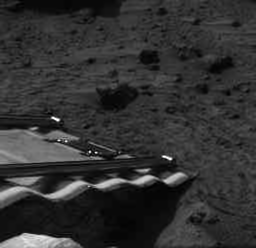
|
|
Was Mars inhabited 3,5 billion years ago ?
In 1975, the orbital photos brought back by the missions " Viking 1 and 2 "
reveal the first morphological traces of drainage on Mars.
The observation, in surface, of a certain number of formations, their organization
in confluence, their meanders, their deposits, recall terrestrial fluvial valleys.
Is it obvious that numerous formations explain themselves by the drainage of a liquid, but which ?
Several hypotheses are advanced, but the one of the water intervening in the process
of the erosion remains the better.
In this case, life could have benefitted this providential manna... before disappearing no one knows how.
The liquid would be himself, one thinks, volatilized 3,5 billion years ago, because, beyond of this period,
there are not more of obvious trace of erosion bound to this element.
A thing is sure: the liquid water doesn't exist to the surface of the planet anymore.
Why? Question of atmosphere: today less dense, its gravity is too weak to preserve its
lightest elements. And, therefore, can not prevent the loss of hydrogen ions, component of water.
One estimates that the atmosphere of Mars is not constituted anymore of 0,03% of water steam.
Consequence: the planet is henceforth hostile to life, because a too fine atmosphere
can not filter the ultraviolet radiance, extremely harmful for all form of life.
Temperatures are, in the same way, extremely low.
Finally, the weakness of the magnetic field can hardly deviate particles of
the solar wind and the cosmic rays.
The different formation observation permits to distinguish two types of erosions.
The privileged explanation is the one of the a great deal of underground water intervening.
If, to the surface, water is again under form of ice or steam, it is but then permit to think
that its basement contains liquid water. An indispensable component to life as we know it.
But the hypothesis of life doesn't limit itself to the presence of aquatic elements.
To have a luck to see it developped itself on a planet, a source of energy, of the carbon dioxide,
also needs a certain number of other elements as nitrogen, sulfur and the phosphorus.
We must also find the trace of microorganisms and fossilized bacteria.
We think that if life appeared, then it exists some even living organisms maybe on Mars,
that waits to be discovered.
Introduction
that the space probe American -Mars Pathfinder - touched Mars.
The space probe was surrounded of a ball cluster that, as of airbags, absorbed
the violence of the fall. Balls rebounded until twelve times and until ten meters
of top after the first impact. And then, the whole is calmed itself and balls deflated themselves.
It is the moment where everybody blew and where everybody took conscience of the importance
of the moment. Before the landing, the space probe entered in the Martian atmosphere at 27.000 km/h.
Hundred twenty seconds before the impact, the parachute of Pathfinder spread out;
the speed fell to 1.620 km/h.
Eight seconds: airbags of protection inflated themselves.
Four seconds: rockets ignited to pull up the module.
Two seconds: the cable of the parachute set the module free.
Pathfinder touched Mars at the speed of 88.5 km/h.
Two hours later, the inflatable balls lost their air and deflated themselves.
The module appears indeed and open out its three solar panels,
like a flower opens its corollas and the small -Sojourner- vehicle can begin its work.
 |
Sojourner take down the Pathfinder module. (Animated GIF, 518kb) |
For more informations, please click here